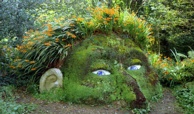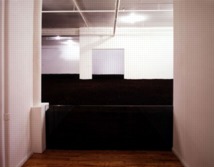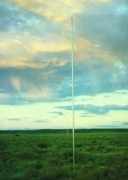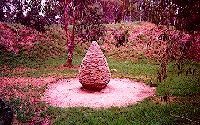

During the late 1960s and early 1970s art began to move outdoors from galleries. Some earthworks have been small enough to be gallery pieces, but many involve huge land masses, as did Michael Heizer's Nine Nevada Depressions, 1968: big, curved and zigzagging trenches, like abstract doodles on the earth, placed intermittently over a span of 520 miles. Another example is the 1970 piece by Robert Smithson (American, 1938-1973) titled Spiral Jetty, which extended 1500 feet into the Great Salt Lake, though today it can be witnessed only through documentation.
Images of earthworks:

There is a long history to the formation of mounds of earth. Some have served burial and other functions, while others have been made for entirely aesthetic reasons. An example of the latter type is the Mud Man sculpture in The Lost Gardens of Heligan of Cornwall, England. Its soil supports various plants, carved stone [or are they cement?] ears, and glazed ceramic eyes. Another photo, taken earlier. See implied.
Joseph Beuys (German, 1921-1986), 7000 Eichen (7000 Oaks), 1982-1996, gingko, linden, bradford pear, sycamore, and oak trees, each paired with a column of basalt stone.

Walter De Maria (American, 1935-), The New York
Earth Room, 1977, an interior earth sculpture: 250 cubic
yards of earth (197 cubic meters), 3,600 square feet of floor
space (335 square meters), 22 inch depth of material
(56 centimeters), total weight
of sculpture: 280,000 lbs. (127,300 kilos), Dia Center for the
Arts, 141 Wooster Street, New York City. The New York Earth
Room is the third Earth Room sculpture executed by the artist,
the first being in Munich, Germany in 1968. The second was installed
at the Hessisches Landesmuseum in Darmstadt, Germany in 1974.
The first two works no longer exist. Also see environment
art.

Walter De Maria, The Lightning Field, 1977. Isolated in
and interacting with the high desert of southwestern New Mexico,
the sculpture consists of 400 stainless steel poles situated in a rectangular
grid array one mile by
one kilometer. A full experience of The Lightning Field
depends upon the opportunity to view it alone or with a small
group of people over an extended period of time. Dia Center for the Arts, which commissioned
and maintains The Lightning Field, schedules overnight
visits in advance, limiting groups to six or fewer persons. Also
see environment art.

Dennis Oppenheim (American, 1938-), Salt Flat, 1968, photograph, map and typewritten text on cardboard,
28 x 22 inches (71.1 x 55.9 cm), Tate Gallery, London. This work
is the documentation of
an earth art
activity that Oppenheim carried out in New York on 28 November
1968 when he spread 1000 pounds of finely granulated baker's
salt on a vacant asphalt parking lot in a rectangle
50 x 100 feet. It comprises a map of Manhattan on which the site
is marked with a cross and a circle,
a color photograph of the salt in position, with the artist standing
beside it, and an explanatory text. The text reads:
SALT FLAT 1968
Location: (part 1) 6th Avenue and 25th Street New York City
1000 pounds of bakers salt 50 x 100 feet on asphalt surface.
Identical dimensions are to be transferred in 1 x 1 x 2 feet
salt lick blocks to ocean floor off Bahama coast xx and dug to
a depth of 1 foot - Salt
Lake Desert, Utah.

Robert Smithson (American, 1938-1973),
Spiral
Jetty, 1970, black basalt rocks, earth and salt crystals,
coil: 1,500 x 15 feet,
 stretching
out counterclockwise into the translucent red water of Great
Salt Lake, UT. As yet this has not been done. Spiral Jetty
was acquired by Dia Center for the Arts as a gift from the
artist's estate in 1999. Robert Smithson's estate maintains a page about this and other works. See volute.
stretching
out counterclockwise into the translucent red water of Great
Salt Lake, UT. As yet this has not been done. Spiral Jetty
was acquired by Dia Center for the Arts as a gift from the
artist's estate in 1999. Robert Smithson's estate maintains a page about this and other works. See volute.
Robert Smithson, Broken Circle, Emmen, Holland, 1971, green water, white and yellow sand flats, diameter 140 feet, width of canal approximately 12 feet, depth of quarry lake 10 to 15 feet.
Robert Smithson, Spiral Hill, Emmen, Holland, 1971, earth, black, topsoil, white sand, c. 75 feet at base.
James Turrell (American, contemporary), Roden Crater, 1972-2000, a natural cinder volcano situated on the southwestern edge of the Painted Desert in northern Arizona. James Turrell is transforming the crater into a large-scale artwork that relates, through the medium of light, to the universe of the surrounding sky, land, and culture.

Richard Long (English, 1945-), A Line Made by Walking, 1967, photograph
and pencil on board,
image: 37.5 x 32.4 cm, Tate Gallery, London. Long created this
earth work by walking back and forth along the same line
in a grassy field in Somerset, England, wearing away a thin path,
which lasted until the grass grew back again. Long took this
photo of his work in order to document
it.

Richard Long, Turf Sculpture, 1967, photograph
on paper, image: 22.9 x 22.9 cm,
Tate Gallery, London.

Andy Goldsworthy (English, 1956-), Cairn,
1997, Herring Island, Australia. See more earth and environmental art on Herring Island.

Andy Goldsworthy, Storm King Wall, 1997-1998, a site-specific
sculpture in field stone, 5 x 2,278 feet overall, Storm King
Art Center, NY.

Andy Goldsworthy, one of Two Oak Stacks, 2003, two large balls
of stacked and knitted oak sticks, Storm King Art Center, NY.
This ball of sticks is directly outside the museum building,
visible through the window of the gallery where the other identical
ball of sticks was constructed
and exhibited. See ephemera, sphere,
and wood.

Andy Goldsworthy, Stone Houses, 2004, two monumental
domes constructed
of wood (split rails from New
England agricultural sources) and stone
(from Scotland), each 18 feet in height
and 24 feet in diameter,
Metropolitan Museum, NY. This installation
is in the museum's Roof Garden, an outdoor space for sculpture
with a great view of the city. The museum says the work was "inspired by Central Park
and its architectural
backdrop. Inherent in these seemingly simple forms
are the implicit power, beauty,
mystery, and elemental
aspects of nature,
marked by the passage of time
and by human contact." See sculpture
garden.
Wim Delvoye, four pieces:
SUE, IN BAR ROUND CORNER SEE YOU THERE. A.
MUM, KEYS ARE YOU KNOW WHERE
DAVID, JUST POPPED OUT FOR A MOMENT, BACK IN TEN MINS.
TIME TO GO. CATCH YOU LATER, A.
photographs
altered so that texts appear to have been carved
into living rock, published
in the printed and web-based art periodical TRANS> arts.cultures.media, Vol.1/2,
No.3/4, 1997.
Earth art's emergence in the 1960s was simultaneous with that of the ecological movement, Arte Povera and process art, with each of which it had a kinship. Earthworks can be considered part of the category of works known as environment art.
Also see conceptual art,
entropy, interdisciplinary,
and living rock.
https://inform.quest/_art
Copyright © 1996-![]()